Batman is 75 this year, and so I’ve found myself thinking about Batman a lot lately. Especially the Batman stories written by Frank Miller – not only because he wrote two of the most important, definitive Batman stories of the modern era (The Dark Knight Returns, a story about a middle-aged Batman coming out of retirement well past his prime; and Batman: Year One, retelling Batman’s origin and his earliest missions as a young superhero), and not only because his Dark Knight Returns portrays an older Batman that can give us insight into what it means for the superhero genre to be entering serious retirement age, but also because, at a time when a very specific idea of Batman is extremely visible in our culture, Frank Miller’s Batman is probably the most influential and simultaneously controversial version of the character.
All of Miller’s Batman stories take place in a single continuity, a reality within the DC Comics multiverse known as Earth-31. This includes Miller’s Batman stories Year One, All-Star Batman & Robin the Boy Wonder, The Dark Knight Returns, and The Dark Knight Strikes Again. While Year One and The Dark Knight Returns are nearly universally loved and praised, All-Star Batman & Robin and The Dark Knight Strikes Again are almost universally reviled and are even offered as evidence that Frank Miller has himself lost his mind.
Comics journalist Cliff Biggers called it “one of the biggest train wrecks in comics history,” and Iann Robinson of CraveOnline went so far as to say “In one fell swoop, Miller has erased all the good he did for Batman with The Dark Knight Returns and Batman: Year One.”All of that is just gone.”
I reread those books just now. All-Star Batman and The Dark Knight Strikes Again are not as good as Year One and Dark Knight Returns. But they’re still pretty good. They’re still really good Batman stories, actually, and it made me wonder why people hate on them so much – on All-Star Batman especially. And I think I’ve got a pretty good idea.
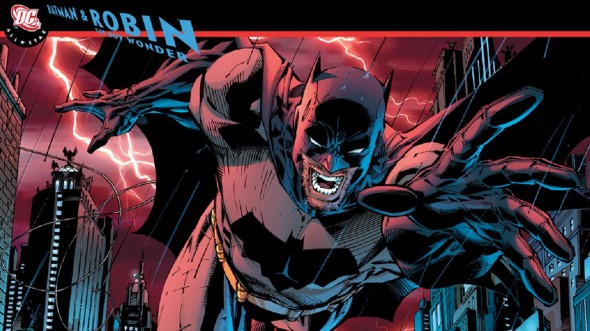
Miller’s latter Batman books were all written after Miller either became a political conservative, or became more politically conservative, or just started feeling comfortable enough to be vocal about his politically conservative views. Comics readers, I think it’s safe to say, generally consider themselves on the liberal side of the spectrum if they have any sort of affiliation at all, and in the same way that Fox News likes to accuse anything created by a liberal to be a work of Commie propaganda, liberals can also feel suspicious when they think that someone whose views oppose their own is trying to use art to promote a hidden agenda – especially if the creator is taking what they see as liberties with characters that the person cares about.
In the opinion of George Passmore, one-half of the British art duo Gilbert & George and one of the few admitted conservatives in the art world, “You’re not allowed to be Conservative in the art world, of course. Left equals good. Art equals Left. Pop stars and artists are meant to be so original. So how come everyone has the same opinion?” One can imagine that Frank Miller feels similarly.
It’s certainly true that the Batman of All-Star Batman (and all the other characters, too) seem very exaggerated and over-the-top compared to their portrayals elsewhere. But Miller’s Batman has always been partly satirical and was never meant to be taken one hundred percent seriously. Miller writes Batman stories at times when superhero comics are trying to get grittier and more “realistic,” and his work typically asks the question (picked up frequently, since DKR, by other Batman writers): what kind of a person dresses up like a bat and runs around beating the crap out of people? The answer, of course, is: someone who is totally (pardon the pun) batpoop crazy. And not just “comic book crazy,” either.
Most importantly, Miller’s Batman is someone who, in-world, inspires imitators while being consciously aware that he is precisely the kind of person who should not be imitated. Miller keeps returning to this theme – Batman as inspiration – because it’s a huge part of what he’s trying to say about superheroes in general and how they function as cultural figures in our world, which informs what kind of superhero stories we should be telling and why.
All-Star Batman is absolutely much less subtle than The Dark Knight Returns was, but ours is a less subtle age where Batman needs to be differently different, if you see what I mean, in order to make the same point that Miller was making in DKR.
But the main point, I think, is that at the most fundamental level, Batman is and always has been about fear. Batman is about what makes us scared and how we should respond to those things that scare us. Bruce Wayne was so traumatized by the death of his parents that fear overtook his whole life. His response was to become the thing he feared most – bats, which had already terrorized him long before his parents’ murder – and use that to turn fear itself against his other great fear – crime in general, and Gotham City’s criminals in particular. Rule-breakers, forces of disorder.
Which is why a conservative’s take on Batman is precisely the perfect perspective on the character. As science has now proven, fear and conservatism are intimately linked.
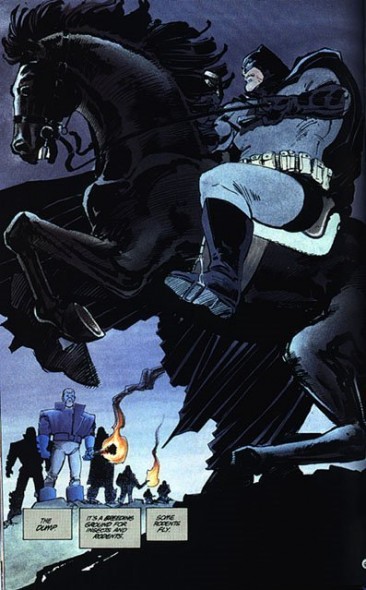
According to the social psychologist Paul Nail of the University of Central Arkansas, conservatives are more likely to feel anxious and threatened in general than liberals, and people all across the political spectrum became more conservative following September 11th, when America’s vulnerability to terrorism became extremely apparent to everyone – and this is very relevant to the case of Frank Miller in particular, who was living in New York City at the time of the attack, and whose conservatism seems to have been either crystallized or revealed by that event. Interestingly, a similar thing happened to the comedian Dennis Miller, making me wonder if people named Miller are more likely to be conservative, or what.
Batman’s motivation is fear, and his greatest weapon is also fear. And it certainly works, but the problem is that in the long-term, fear only begets more fear. Batman defeats criminals, ultimately, by being scarier than they are. When Miller writes Batman, what’s always at the forefront of the story isn’t whether or not fear is an effective deterrent to crime (it is), but what happens to society in the long-run when fear is the only thing keeping the criminals in check. And Miller is very careful never to come down too strongly on one side of the argument or the other; he presents both sides of the argument with all their pros and cons completely visible. Which is why, in DKR, it’s so shocking to see some of the “man on the street” interviews with Gotham’s citizens on the topic of Batman after he comes out of retirement and starts beating people up again.
When one of his supporters says, “Batman? Yeah, I think he’s A-okay. He’s kicking just the right butts – butts the cops ain’t kicking, that’s for sure,” you’re pretty much on board, you sympathize with his perspective. That is, until the next sentence out of his mouth is, “Hope he goes after the homos next.” You’re instantly knocked out of who you thought this guy was, and it makes you totally re-evaluate whether you want to be on the same side as him anymore. Then in the very next panel, when another Gothamite takes the opposing attitude, saying, “Makes me sick. We must treat the socially misoriented with rehabilitative methods,” you’re still recovering from the shock of the last guy’s opinion and might be inclined to agree that Batman is doing the wrong thing. But the guy then continues, “We must patiently realign their – excuse me? No, I’d never live in the city.” And you’re recontextualized again, you internally respond, “easy for you to say, buddy!”
The thing is, we get that. Why, then, twenty-two years later, when Miller shows us his version of Robin’s initiation as sidekick, do we get so bent out of shape? In All-Star Batman, after Batman more or less kidnaps the 12-year-old Dick Grayson after the public murder of his parents, they have this exchange as they flee from the scene in the Batmobile:
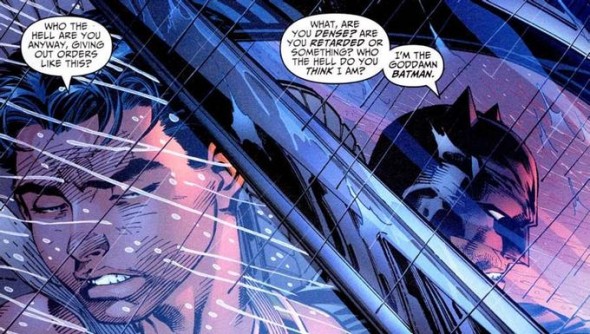
This line became an infamous meme, an exemplar of how far Miller had fallen since the triumphant Dark Knight Returns. In All-Star Batman, the Caped Crusader is depicted as half-crazy, extremely sadistic and generally contemptuous of everyone around him (including his fellow superheroes, particularly Superman and Green Lantern). But the whole point, which is in no way made subtle or obscure in the comic, is that Batman is trying to scare Dick Grayson. He is fully aware that the most effective weapon in his arsenal is fear, that fear is what keeps the bad guys in check. Bruce Wayne had been watching Dick Grayson for years, seeing him as an acrobatic genius who could become a really effective hero; but he is forced to recruit Dick years earlier than he had planned when the boy’s parents are murdered right in front of him. Batman becomes increasingly frustrated as the grieving Dick stays calm despite the madness around him – “No matter what I say,” Batman thinks, “No matter how I play it – this kid just won’t scare.” Batman needs Dick Grayson to get scared, because, as he sees it, you have to know fear in order to wield it as a weapon. Because Batman understands that you can’t be brave unless you’re afraid.
But this portrayal of Batman was beyond the pale for most readers. In our current era, where a lot of people seemingly love nothing more than to get offended, it was simply unacceptable for Batman to abuse the young Robin in this way, or to use the word “retarded.” Similarly, when Robin later asks what Batman calls his car, and is told, “the Batmobile,” his response is, “That is totally queer.” People took offense to this and blamed Miller for insensitivity – rather than understanding that the whole point is here is this dumb twelve-year-old kid, of course he’s going to say something ignorant and offensive. Batman’s whole modus operandi is completely infantile, and so is the name of his car, and Batman hates to have this pointed out to him. In All-Star Batman, Bruce Wayne had only donned the cape and cowl less than two years earlier; when a middle-aged Batman returns thirty years later, including ten years of retirement, he’s obviously going to be a much more mature and subtle person. He couldn’t have survived otherwise. But rather than treating the young Batman with the appropriate ambivalence that Miller intended, the majority of readers made a knee-jerk judgment: we don’t like this Batman, and so we don’t like Miller. Or possibly: we don’t like Miller anymore, so we don’t like this Batman.
In an article on fear and conservatism that appeared in Scientific American, we’re told that “a team led by psychologist Michael Dodd and political scientist John Hibbing of the University of Nebraska–Lincoln found that when viewing a collage of photographs, conservatives’ eyes unconsciously lingered 15 percent longer on repellent images, such as car wrecks and excrement—suggesting that conservatives are more attuned than liberals to assessing potential threats.” And no one is more attuned than Batman at assessing potential threats – Batman plans for every possible contingency, which is why he can almost always triumph even over enemies much stronger than him or those with superhuman abilities. Paul Nail, again, explains the conservative viewpoint, saying, “The fact is we don’t live in a completely safe world. Things can and do go wrong. But if I can impose this order on it by my worldview, I can keep my anxiety to a manageable level.” That describes Batman to a T, and it’s the reason that Miller’s Batman is so compelling – and so infuriating. Miller understands that Batman is about fear, that everything he does is a response to fear – and it’s also why Christopher Nolan, whose recent Batman films are heavily indebted to Frank Miller, also inspired a great deal of suspicion from people who thought the Dark Knight movies seemed a little bit fascist; from accusations that The Dark Knight was effectively an apologetic or justification for the Bush Administration’s warrantless wiretapping scandal, and The Dark Knight Rises a thinly-veiled critique of the Occupy movement.
Similarly, the movie 300, based on Frank Miller’s graphic novel of the same name, was seen by some as propaganda advocating an American attack on Iran; Miller’s 2011 graphic novel Holy Terror (which was originally meant to be a Batman story, until Miller decided it would be better using characters that were legally distinct from Batman, Catwoman, etc, to tell his story of a superhero taking on an Al Qaida cell in the United States) was also excoriated by mainstream press and readers, who accused it of being a destructive and reductive fantasy at best, or outright racist at worst. For the record, Holy Terror is a fairly mediocre book, but it isn’t racist. Miller himself said that he intended Holy Terror to be a piece of propaganda, in the proud tradition of American propaganda comics. Said Miller, “Superman punched out Hitler. So did Captain America. That’s one of the things they’re there for.”
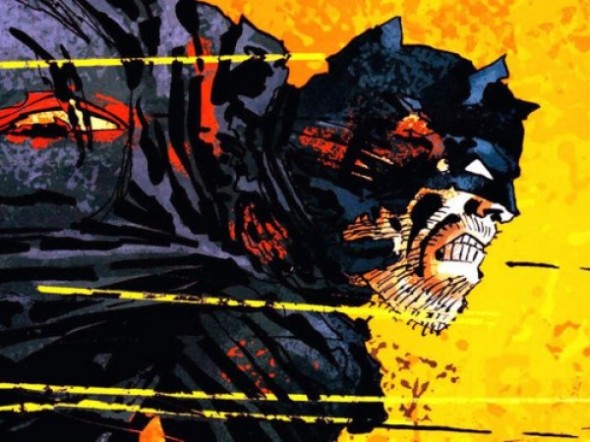
But it’s a mistake to dismiss All-Star Batman as just another of Miller’s right-wing power fantasies. It’s very important to realize that Batman’s fear is not irrational. He isn’t paranoid. His fear is honest and proportionate, and his response to it is effective and well-reasoned. Batman isn’t an uncomplicated or stereotypical conservative either – he’s very anti-gun, for example. He’s not religious. He refuses to use lethal force, even when he knows that allowing an enemy to live will lead to that enemy killing more people in the longrun. Batman’s fear is relatable in a way that, say, Superman’s isn’t – Batman, a mere mortal, knows very well that he can be hurt; worse, he knows from experience that the people he loves are fragile and that life is always precarious. Besides the deaths of his parents, Batman witnessed the murder of Jason Todd, the second Robin, at the hands of the Joker (in Jim Starlin’s story A Death in the Family) , as well as the brutal assault and paralysis of Barbara Gordon, the one-time Batgirl, also by the Joker (in Alan Moore’s story The Killing Joke); although Jason Todd has subsequently come back to life, of course, and the latest reboot of the DC universe restored Barbara Gordon’s mobility, many Batman stories deal with his guilt at allowing these tragedies to occur. And this is another major factor in the psychology of Miller’s Batman: Batman inspires imitators, and he hates that. In The Dark Knight Returns, 13-year-old Carrie Kelly styles herself as the new Robin, and a number of ex-members of the Mutants gang whose leader Batman beats the crap out of turn into a swarm of vigilantes calling themselves “Sons of the Bat” who go around punishing wrongdoers with severely disproportionate force. In All-Star Batman, Black Canary and Batgirl are both spurred by Batman’s example to take on the cause of their own fears, mostly in the form of certain of Gotham’s citizens who have particularly entitled attitudes and believe that they should be able to do as they please and take what they want. Batman does not approve of these imitators – his attitude is “do as I say, not as I do.” He doesn’t trust anyone but himself – or those he has personally selected and trained – to fight the war against Gotham’s criminals and the crooked cops who enable them, because he knows exactly how dangerous it is out there. If and when anyone gets hurt or killed trying to emulate him, because they feel the same fear that he feels, Batman feels personally responsible.
Batman is a paradox, but he’s not confused about himself: his motivations and the effects of his actions are completely transparent to him. He’s totally self-aware. He knows exactly how crazy he is, and he know that his craziness works to his advantage because it makes him that much scarier. That’s the context in which we should be reading All-Star Batman. It also explains Batman’s unconcealed contempt for other superheroes in the Earth-31 continuity.
In the same article in Scientific American, the author writes that “a team led by Yale University psychologist Jaime Napier found that asking Republicans to imagine that they possessed superpowers and were impermeable to injury made them more liberal.” Miller’s Batman thinks that Superman is basically a stooge, and that Green Lantern is a straight-up idiot. In All-Star Batman, when these other heroes come to Batman to ask him to tone down his brutality – to be less scary, in other words – Batman makes it clear that he has no respect for them at all. Nothing short of an atomic bomb can hurt Superman, so what has he got to be afraid of? Superman can afford to be as gentle as he possibly can. The final issue of All-Star Batman features a crazily one-sided fight between Green Lantern and the recently recruited Robin, which takes place inside a room that’s completely painted yellow (with Batman and Robin themselves painted yellow as well), to take advantage of this version of Lantern’s weakness against yellow-coloured objects. Robin kind of flips out and nearly accidentally kills the powerless Green Lantern with a punch to the throat, and Batman is forced to save Lantern’s life with an emergency tracheotomy.
That final fight between Batman’s ward and the superhero Batman loathes the most is thematically extremely important to the point that Miller is trying to make about where Batman fits in the world of superheroes and how what superheroes represent ought to inform our understanding of those issues. Green Lantern is a test pilot who was given the green ring of power by an alien who was a member of the interstellar police force the Green Lantern Corps. This alien, Abin Sur, commanded the ring to find a suitable earthling to wield it, a person who was “utterly honest and born without fear.” The ring found Hal Jordan, who became Earth’s Green Lantern. And that is precisely the point: Green Lantern isn’t afraid of anything, and Batman knows exactly how stupid it is to be fearless. Batman continually correlates Lantern’s fearlessness with his utter lack of imagination and resulting uselessness as a superhero: “He’s got the imagination of a goddamn potato,” Batman asserts. “He makes giant green fishing poles and mousetraps when he could, well…”
He could do anything with that kind of power, is the point. But Green Lantern’s fearlessness, in Batman’s view, is caused by his lack of imagination – the same thing that made Hal Jordan the perfect candidate for Lanternship makes him almost completely ineffectual. If Lantern had any imagination, he would be afraid. Batman is afraid because he knows exactly what is out there in the world, he anticipates every possibility in order to prevent or counter it. Batman’s viewpoint is fundamentally a conservative one: Batman needs order and control; he wants to personally ensure that the only people who get hurt are the ones who deserve to. As opposed to his colleagues like Superman and Green Lantern, Batman lives in a relatively realistic world, and contends with threats that are a lot more like what we in the real world have to deal with than the more cosmic-level and surreally-heightened adventures of many other superheroes.
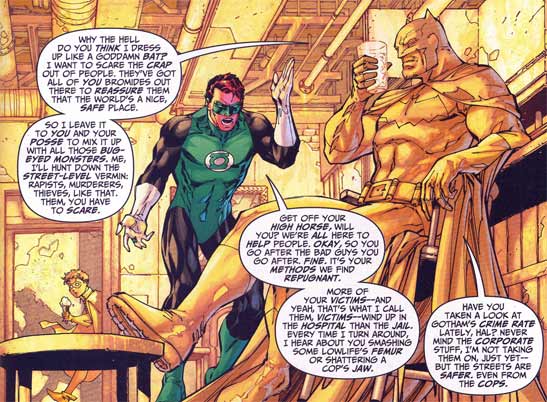
Miller, a conservative, understands this probably more than any other modern Batman writer, but he needs to exaggerate Batman’s neuroses more and more to make the point as we become more and more accustomed as a society to Batman, his motivations and his modus operandi: Batman’s foes are not alien warlords or evil interdimensional clones – they are people who take advantage of other people, people who cause the innocent masses to live in fear. His perspective on crime in fundamentally conservative because he doesn’t believe that going after “root causes” of crime is good enough; Bruce Wayne operates orphanages and donates beyond generously to charity, but in the final analysis Batman believes that what will stop criminals is only the fear of being caught and punished. He’s no “bleeding heart” like Superman or Green Lantern. He’s a “law and order” type. He knows that criminals are a cowardly, superstitious lot. He knows that criminals will respond to fear, because he responds to fear.
Does that make you uncomfortable? Should it?
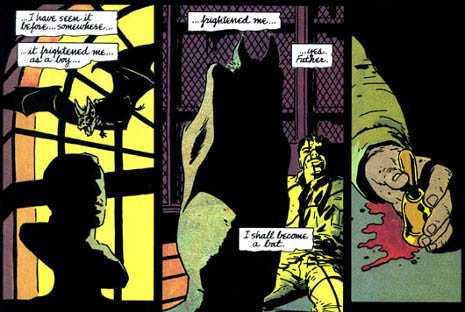
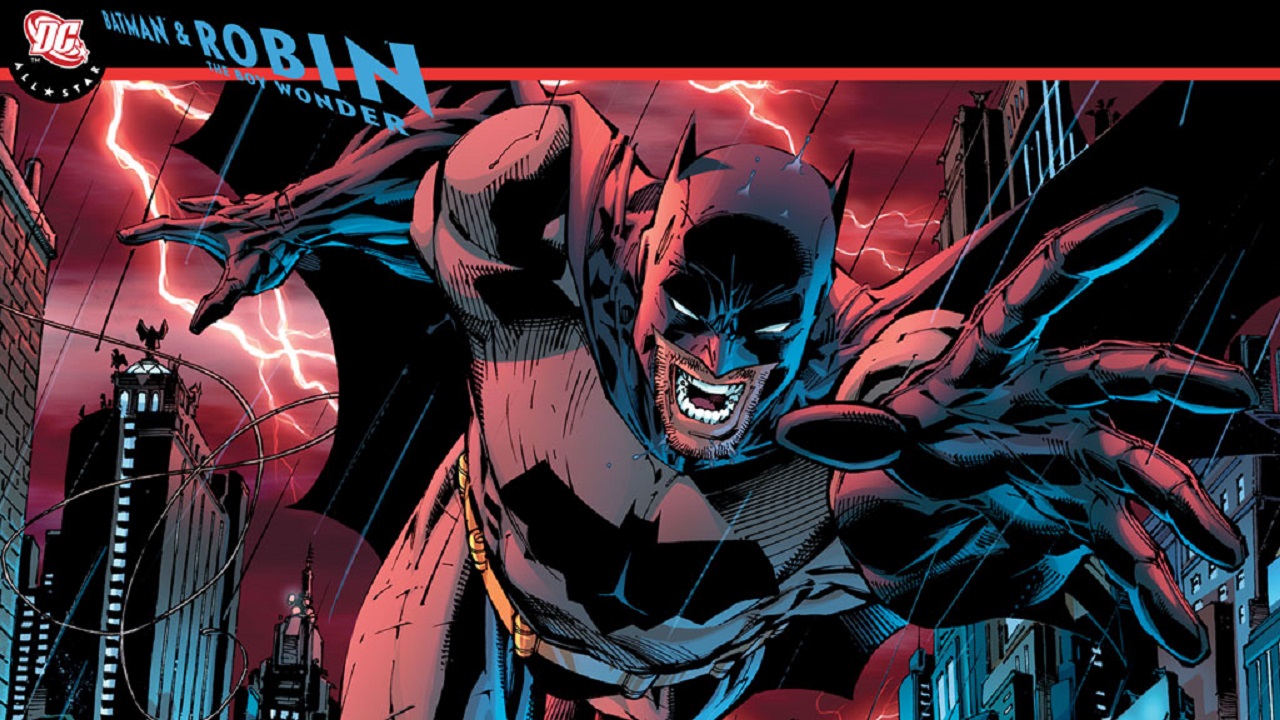
Awesome.
Nice article. Anybody that wields power and “knows” better for me than I do myself, fear or no fear, makes me uncomfortable.
You make the claim that All Star Batman is good but you don’t really make a case for why it’s good. Conservatives are perfectly capable of writing bad things using characters that have the same values they have. Your alternative explanation for why the book is considered bad is definitely a possibility but it doesn’t seem like a stronger possibility then the comics just being bad.
Building on the alternate theories as to why DKR and Year One are well regarded while the follow-ups are not–it is important to note that when Dark Knight Returns came out it was really something new and different in its portrayal of Batman. While it is not really right to say (as many do) that it and Watchmen are responsible for the “grim and gritty” superhero comics of the late ’80s and early 90s (if you read other comics from around that time, it was pretty clear which way things were going), DKR was at the right place at the right time to represent a big turn that was happening in comics. I think if you released the exact comic today it would be greeted with a yawn.
Year One followed immediately after DKR, so it was still a pretty new take, and also has the benefit of David Mazzucchelli as an artist–who is noteworthy for being about the only comics artist I can think of who has worked on both one of the greatest superhero comics of all time AND one of the greatest literary comics of all time (Asterios Polyp, arguably the must-read graphic novel of the ’00s. His comic adaptation of City of Glass is pretty damned excellent as well). By the time DKSA and All-Star Batman and Robin came out, we’d seen it all before. And Jim Lee is no David Mazzucchelli.
I do not understand the love for The Dark Knight Returns. It’s horribly misogynistic for one, homophobic for another. It writes like how a 12 year old would imagine Batman: an infallible badass who’s able to take on rivals with ease, with all women throwing themselves at his feet.
In TDKR, Batman is a thug, rather than a detective. The morally grey issues which are brought up by Miller get solved only through violence. And rather than question this reaction, he glorifies it, even revels in it at times.
And to top it all off the artwork (IMO)looks sloppy and rushed. It becomes unreadable at times.
But thugs are what “superheroes” are. Their whole purpose is to deal out “justice” according to their own whims because apparently the legitimate authorities are incompetent or corrupt. Yes, I know that theoretically Batman is supposed to be “The World’s Greatest Detective”, but I don’t recall any version of him actually being Sherlock.
This is the fault of lazy writers and even laziers editors.
Superman was “the Man of Tomorrow”: a socially aware hero that used inspiration as main weapon, his original stories often put him against white-collar criminals and social injustice. Green Lantern was a worker hero (the lantern itself is a railroad lantern) born on the idea of “what would you do with a wishing ring?”.
All the golden and silver age superheroes worked in conjunction with police and political forces, the “corrupt and incompetent police and government” is a recent spin, influenced by real time event and “the sucking ’90” where everything was “grittier”, darker”… And dumbly juvenile.
Frank Miller’s batman reflects that kind of view, a standard right wing “In my times the things were better” vision. Nostalgia factor played for political issues: but while simple and appealing is a dumb vision of society.
Would that mean that G.W. Bush was not the President that post-9/11 America needed but the president it deserved? Also, does that mean that in the heated right-wing imagination, Obama is Superman (naive but allowed too much power, superficially mirroring America’s ideals while on some fundamental level being alien and strange)?
Okay, this article sounds like it’s defending Miller’s and conservatives views. Explain and justify it. But it also shows it’s flaws. Paul Nail, again, explains the conservative viewpoint, saying,
“The fact is we don’t live in a completely safe world. Things can and do go wrong. But if I can impose this order on it by my worldview, I can keep my anxiety to a manageable level.” (Sounds very Rain Man to me. “Uh oh! Uh oh!”)
So the viewpoint is “We must subjugate the world, control it so it’s chaos doesn’t harm us!” Using terrorism as a justification. And that anyone who is against that (Superman, Liberals, etc) are naive children who put us all at risk. Buuuuuuut, then it ignores the fact that attitude can cause the chaos in the 1st place. I mean that doesn’t sound very open to freedom or democracy right? Blowback the CIA calls it. When their operations in other countries cause hate and resentment in their people. For our 9/11 2001, Chile had it’s 9/11/1973. When their democratically elected government was overthrown in a violent coup. And replaced with a US business friendly puppet.
Which makes me counter argue that I think it makes the conservatives naive children who put us all at risk, with their over reaction to fear. Shredding Habeus Corpus so “those dam hooligans can’t hide behind lawyers!” Shredding the 4th Amendment by tapping every one’s phones. And if you’ll notice, leaving the 2nd Amendment alone. because being armed lessens mental anxiety. Gun violence might blow up, but at least they have a sense of agency if they have their own weapon.
This was a great essay. I’ve had a problem with Miller over the years for reasons you essentially laid out. But through the lens you prescribe, it makes sense how a character like Miller’s Batman exists.
It’s interesting to parallel your discussion of All Star Batman with All Star Superman, which tried to encapsulate everything great about the Man of Tomorrow in twelve comic books. I’m not sure what this lens of Batman means for Superman, but it’s something I’m gonna mull over.
This is such a braindead take. Miller’s muddled politics are the least interesting thing about any of his works. His later work is criticized not because it’s “more conservative” but because it reads like a bad parody of his good work.